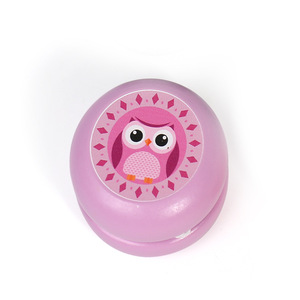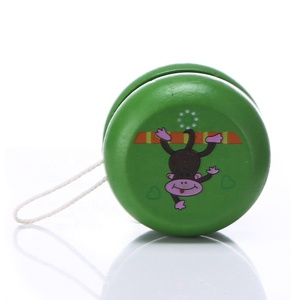(2427 products available)












































































































































































































There are many types of 3 yoyo, which are as follows:
Butterfly Yo-Yos
These toys have a winged shape with a wide gap in the middle. They are helpful for performing tricks because of their shape. This makes them stable when doing tricks. They are great for young children who want to learn yoyo tricks. This is because they are easy to use. They are also available in many colors and designs. Some even have lights that make them look cooler.
Classic Yo-Yos
These, as the name suggests, are the traditional yoyos. They have a simple design. They have two halves that are joined with an axle and a string. They are great for beginners. This is because they are easy to use. They can spin up and down the string with little practice. They have a smaller gap between the halves. This makes them less stable when doing tricks. However, they are still fun to use.
Light-Up Yo-Yos
These yo-yos have LED lights inside. The lights switch on when the yoyo is spinning. They make playing with the yoyo super cool in low-light conditions. They come in many styles, like butterfly and classic yo-yos. They are great for yo-yoing and as a light-up toy. Kids of all ages enjoy playing with them.
Pro Yo-Yos
These yoyos are for expert users. They have a wide gap for better stability when doing tricks. They are made from metal or high-quality plastic. This makes them spin longer. They also have different features. For example, some have ball bearings for a smoother spin. Others have adjustable response systems. This lets users customize how the yoyo comes back up. These yoyos are more expensive. However, they are worth it for serious yoyo players.
When choosing a yoyo for a child, consider their skill level, what tricks they want to do, and how much money they want to spend. A beginner might start with a responsive yoyo, while someone with experience could use an unresponsive yoyo. A yoyo might be good if a kid wants to try different things. The cost of a yoyo can vary based on its type and features, so think about how much money someone wants to spend. It's also essential to get a yoyo that feels comfortable in hand and matches the child's interests.
To ensure the yoyo toy is safe for kids and meets the quality standards, here are some things to look out for.
Material safety
Check if the yoyo is made from safe materials. Manufacturers should use materials that do not contain lead or phthalates. The yoyo should also have a material safety data sheet.
Choking hazard
Does the yoyo have small parts? If yes, ensure they are well attached. Some yoyos have a cover over their axle to prevent kids from touching small parts that can be a choking hazard. Always supervise younger kids when playing with a yoyo.
Proper construction
The yoyo should be well constructed. Its halves should not come apart easily. The axle should also be well covered. A well-constructed yoyo will not break easily. Kids can then play with it for a long time without any safety concerns.
Age appropriateness
Manufacturers usually label yoyos with the appropriate age. For example, the 3 yoyo is for kids three years and up. This means the yoyo is easy to use and won't pose any risks. It is also important to get yoyos with handles for younger kids. Regular yoyos may be difficult for younger kids to use.
Certifications
Look for certifications from trusted organizations. This shows the yoyo has passed all the safety and quality tests. Some certifications include ASTM F963, CE markings, or EN-71.
Durability
Get a yoyo made from durable material. It should also have a strong string. This way, kids can use the yoyo as often as they like. It won't break or wear out quickly. The yoyo will last many years with proper use.
Brand reputation
Buy from well-known brands or manufacturers. They are well-known for their quality and safe products. Read reviews to see what other buyers say about the yoyo. Their experience shows if the yoyo is safe or worth getting.
Q1: What are the benefits of yo-yos for children?
A: Yo-yos can improve hand-eye coordination and fine motor skills in children. Some models, like responsive ones, are easier to use. They also offer a fun, screen-free way for kids to play, which can boost their creativity and problem-solving skills.
Q2: How can parents ensure their child's safety when using a yo-yo?
A: Choosing the right yo-yo for a child's age and skill level is important. For younger kids or beginners, responsive yo-yos are safer since they come back up easily. Also, parents should check that the yo-yo is well-made and doesn't have small parts that could be a choking hazard.
Q3: What are the typical materials used in making yo-yos?
A: Yo-yos are usually made from plastic, metal, or a mix of both. The shells are often high-quality plastics like polycarbonate or aluminum, which make them strong. The materials chosen affect how well the yo-yo performs and lasts.
Q4: How can someone care for their yo-yo to make it last longer?
A: Giving yo-yos a gentle wipe after each use removes dirt and oils that could harm them. Storing in a clean, dry pouch or case keeps them safe from damage. Lubricating the axle occasionally helps moving parts work smoothly and extends the life of the toy.
Q5: What makes a yo-yo suitable for advanced tricks?
A: Yo-yos designed for tricks have features that enhance performance. They use dual or ball bearings for longer spins, crucial when doing complex tricks. A wide or V-shaped gap allows easier string access. Also, these yo-yos are often made from durable metals that can take a beating.
The keyword "3 yoyo" maintains a consistent average monthly web search volume of 10, without any significant changes over the past year. Detailed examination of monthly data reveals a stable pattern, with occasional months showing zero web searches. This trend has remained steady from December 2023 through November 2024.
In the web search volume data for "3 yoyo," we observe a recurring pattern where certain months report zero web searches. Specifically, February 2024 and June 2024 saw no web searches for this keyword. Despite these dips, the keyword consistently recovers, with subsequent months typically returning to a web search volume of 10. This indicates a stable, albeit low, interest level in the keyword, with no significant fluctuations over the year.
The consistent web search volume with occasional drops suggests a niche interest in the "3 yoyo" product. The lack of growth or decline in web search volume over the year implies that the market demand for this item has reached a plateau. The keyword's performance does not show any seasonal trends, as the pattern of zero web searches in February and June does not align with typical seasonal buying behaviors. This analysis suggests that while the product has a dedicated but limited audience, it does not currently attract broader market interest.